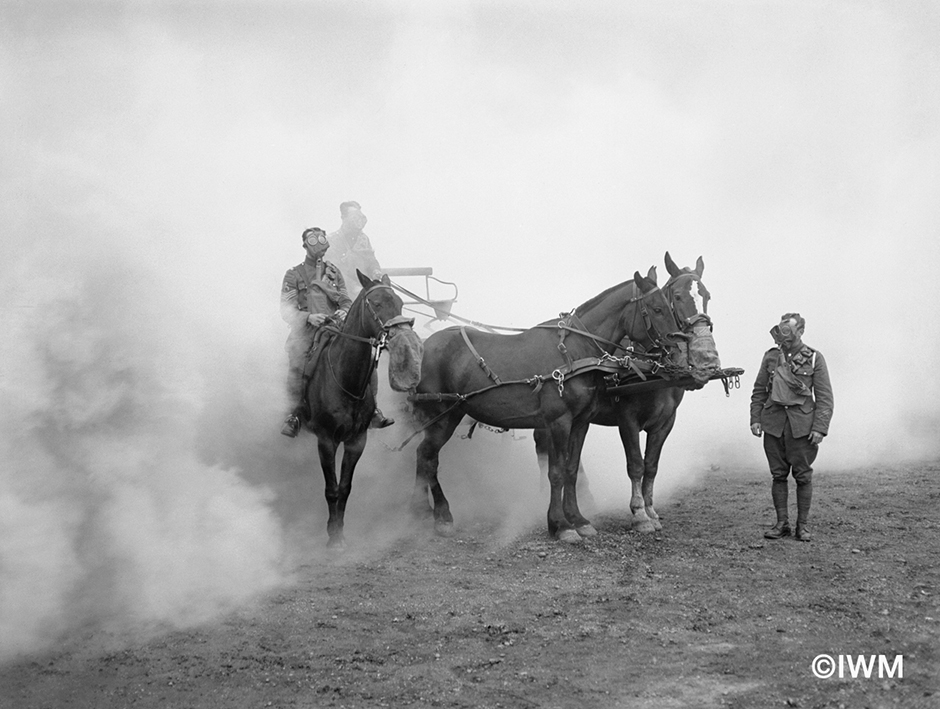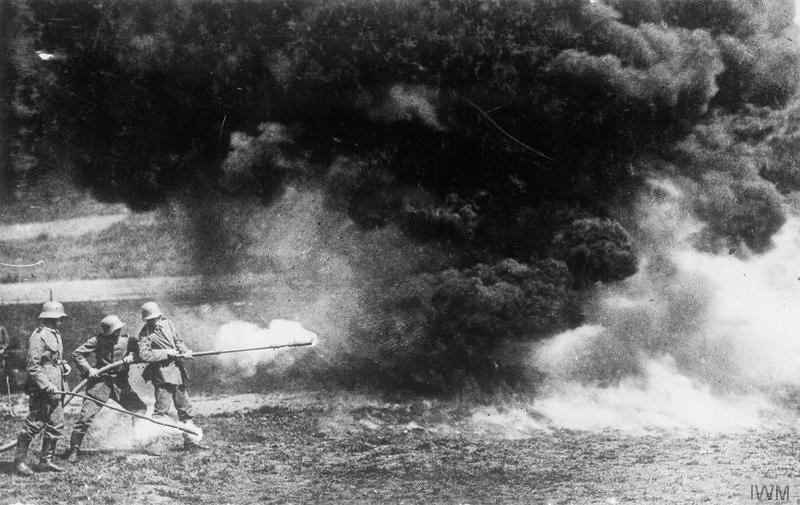2nd Battle of Ypres and other conflicts 1915

Horses and men wearing gas masks undergoing an anti- gas drill in the U.K.
Image courtesy of the Imperial War Museum, image IWM Q34105.
2nd Battle of Ypres
April 21st – May 25th 1915
The 2nd Battle of Ypres lasted from April to May 1915 and comprised four battles in the northern sector of the Ypres Salient: Gravenstafel (April 22 – 23), St Julien (April 24 – May 4), Frezenberg (May 8 – 13) and Bellewarde (May 24 – 25). It was fought for strategic control of the town and was the only major attack launched by the Germans on the Western Front in 1915. The battle is notorious for having the first use of chlorine gas against the British by Germans, who released 168 tons on 22nd April. The Second Army was present.
Battle of Frezenberg Ridge
May 8th – 13th
Fierce German assaults over the course of the battle pushed the Allies back. The Canadian Light Infantry managed to hold the line at great cost and loss of life.
May 13th 1915. Death of Private 8200 Walter Draper, 10th Bn. (Prince of Wales Royal) Hussars, 3rd Cavalry Division, a former market gardener from Radcliffe. He was missing in action, age 19.
By the end of the 2nd Battle of Ypres, the city was demolished. The British had about 7000 gas casualties, of whom 350 died, and about 60,000 casualties overall.
Battle of Hooge, Belgium
July 30th 1915

German flame throwers in action on the Western Front.
Image Q41844 by official German photographer, courtesy of the Imperial War Museum.
Hooge lay east of Ypres and was the site of intense fighting between the Germans and British throughout the war, control passing between them. At the end of July 1915, it was in German hands. The battle is renowned for the first use of liquid fire (flame throwers) by Germans. Second Army was present.
July 30th 1915, Hooge, Belgium. Private 2750 Samuel Oliver, 1st/8th Bn. Sherwood Foresters, 139th Brigade, 46th Division, who lived in Radcliffe as a child, was killed in action at 3.30 a.m. Age 24.
From Sherwood Foresters Regimental War Diaries (held at the Worcestershire and Sherwood Foresters Regimental Museum, Nottingham)
Enemy commenced heavy bombardment on Hooge. At same time 84 reported wood on fire in front of them and subsequently attack by a party of bombers. This was beaten back and they left 2 officers dead behind them. On enquiring position from left from Officer Commanding 7th K.R.Rs. he stated that enemy had attacked with liquid fire and that his Brigade had lost the trenches G3 to Gl4, and he could not say whether his Battalion was in touch with the Battalion on left or support line or not. Reported situation to General who stated that we were to hold the line at all costs and that if, as we feared, the enemy came through Zouave Wood he would counter attack with his reserves. Officer Commanding 88 took steps to strengthen the flank of his trench in case G12 was evacuated by troops on our left. 2.00pm. Bombardment of the trenches taken by enemy.
2.45 pm Counter attack – failed utterly owing to exhaustion of the men – (the Brigade on our left). 7th Battalion Sherwood Foresters were subsequently placed at disposal of the 14th and were ordered to line across from 88 to Zouave Wood. On our urgent representations the Brigade Commander 42nd Brigade allowed them to dig themselves in, in order to protect our flanks.
Other 1915 Conflicts
October 5th 1915, Mount Bernanchon, Bethune, France. L/Corporal 286 Ernest Hale, 1st/8th Bn. Sherwood Foresters, 139th Brigade, 46th Division, who moved from Radcliffe to Nottingham before the war and was a regular soldier, was killed in action, age 22. The Battalion War Diary reports:
Oct 3rd Battalion marched out from Bethune and went into billets at Mt. Bernanchon, arriving about noon. Remainder of day was spent in settling down.
Oct 4th Bombing practice in morning. Reserve machine gunners under MGO (Master General of the Ordnance). Just as Battalion falling in for afternoon parade orders received to embus at 3.30pm to proceed to a point near Vermelles. The Battalion went into German trenches and were occupied on night of 4th in cleaning up trenches.
Oct 5th Several casualties from enemy shell occurred. Battalion knew nothing of ration arrangements and there was great difficulty in obtaining water. Orders were received about 5.00pm to leave trenches and march to Mazingarbe where billets had been arranged by Staff Captain. Cookers were brought to new billets and there was tea for the men on arrival about 7.00pm.
November 24th 1915: Ypres Salient, Belgium. Shoeing Smith 99092 Clarence Moody, Ammunition Column, Royal Field Artillery, 47th Brigade, 14th Division, a married man and former blacksmith in Radcliffe, was killed in action in Belgium, West Vlaanderen area. Age 28.
